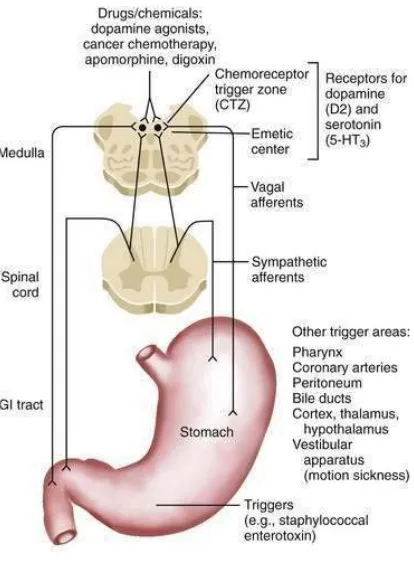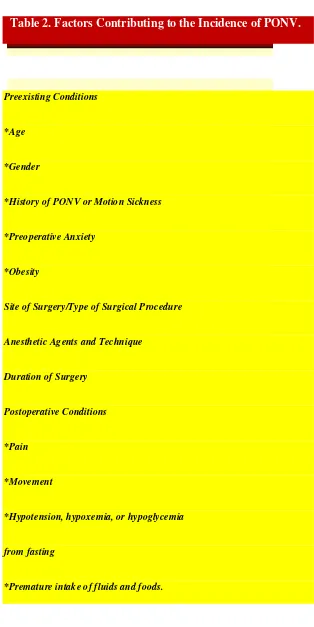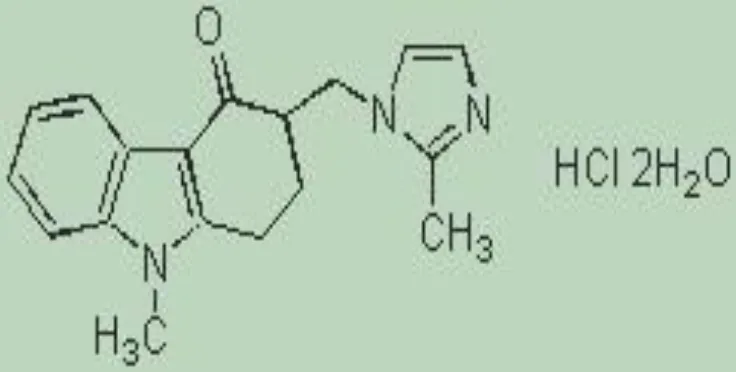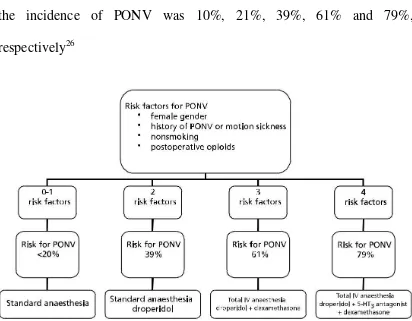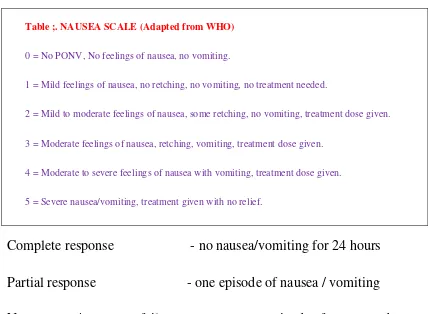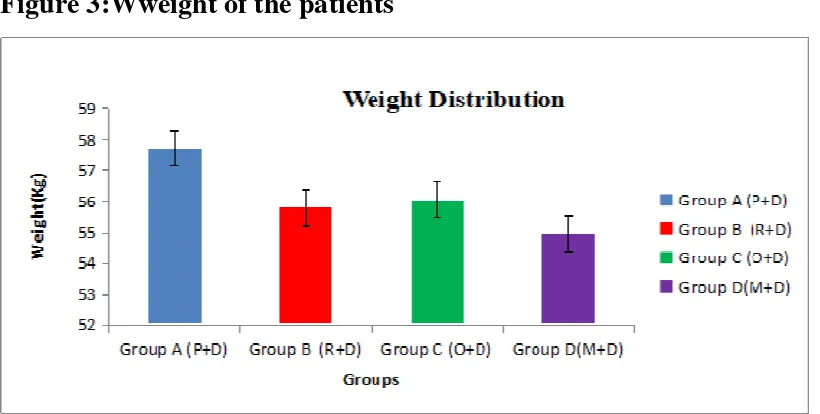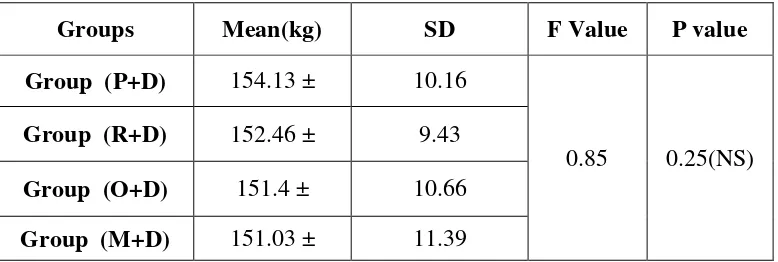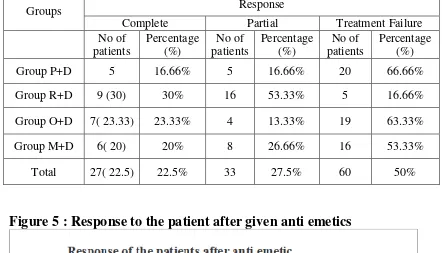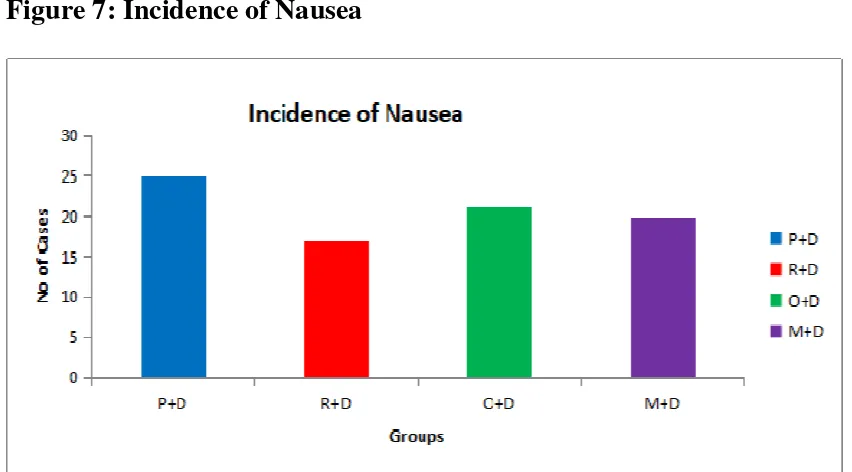“
COMPARISON OF THREE GROUPS OF
ANTIEMETIC DRUGS FOR PREVENTION OF
POST OPERATIVE NAUSEA AND VOMITING
AFTER MIDDLE EAR SURGERY
”Dissertation submitted to
THE TAMIL NADU DR. M.G.R. MEDICAL UNIVERSITY In partial fulfilment for the award of the degree of
DOCTOR OF MEDICINE
IN
ANAESTHESIOLOGY
BRANCH X
INSTITUTE OF ANAESTHESIOLOGY AND
CRITICAL CARE
MADRAS MEDICAL COLLEGE
CERTIFICATE
This is to certify that the dissertation titled “COMPARISON OF
THREE GROUPS OF ANTIEMETIC DRUGS FOR PREVENTION
OF POSTOPERATIVE NAUSEA AND VOMITING AFTER
MIDDLE EAR SURGERY” submitted byDR.M.KASI in partial fulfilment
for the award of the degree of DOCTOR OF MEDICINE IN
ANAESTHESIOLOGY by The Tamilnadu Dr.M.G.R MEDICAL UNIVERSITY, CHENNAI is a bonafide record of work done by him in the INSTITUTE OF ANAESTHESIOLOGY& CRITICAL CARE, Madras
Medical College, during the academic year 2015 -2018 .
Prof DR.B.ANURADHA SWAMINATHAN , MD,DA Director and Professor
Institute of Anaesthesiology& Critical care Madras Medical College
Chennai-600003
DR.R.NARAYANA BABU,MD,DCH The Dean
CERTIFICATE OF THE GUIDE
This is to certify that the dissertation titled “COMPARISON OF
THREE GROUPS OF ANTIEMETIC DRUGS FOR PREVENTION
OF POSTOPERATIVE NAUSEA AND VOMITING AFTER
MIDDLE EAR SURGERY ” in partial fulfilment for the award of the degree of Doctor of Medicine in Anaesthesiology by the Tamil Nadu Dr. M.G.R. Medical University, Chennai., is a bonafide record of the work done by him in the INSTITUTE OF ANAESTHESIOLOGY AND CRITICAL CARE, Madras Medical College and Rajiv Gandhi Government General Hospital, during the academic year 2015-2018.
Prof DR.VELLINGIRI.,MD.,DA.,
Institute of Anaesthesiology & Critical care Madras medical college
Chennai-600003
DECLARATION
I hereby declare that the dissertation titled “COMPARISON OF THREE GROUPS OF ANTIEMETIC DRUGS FOR PREVENTION
OF POSTOPERATIVE NAUSEA AND VOMITING AFTER
MIDDLE EAR SURGERY” has been prepared by me under the
guidance of PROF.DR.VELLINGIRI,MD,DA, Professor of Anaesthesiology, Institute of Anaesthesiology & Critical care, Madras Medical college, Chennai, in partial fulfilment of the regulations for the award of the degree of M.D (Anaesthesiology),examination to be held in April 2018.
This study was conducted at Institute of Anaesthesiology & Critical care, Madras Medical College, Chennai.
I have not submitted this dissertation previously to any journal or any university for the award of any degree or diploma.
Date:
ACKNOWLEDGEMENT
I am extremely thankful to Dr.R.NARAYANA BABU.,MD.,DCH
The Dean, Madras Medical College, for her permission to carry out this study.
I am immensely thankful and indebted to Prof.DR.ANURADHA SWAMINATHJAN.,MD.,DA., the Director and Professor, Institute of Anaesthesiology &Critical care, for her concern ,guidance and support in conducting this study.
I am extremely thankful to Prof DR.VELLINGIRI,MD,DA., for his concern ,inspiration, meticulous guidance, expert advice and constant encouragement in doing this study.
I am very much indebted to Assistant Prof. DR.CATHERINE RATHINASAMY., M.D., ,for their timely guidance and invaluable help in conducting this study
I am thankful to institutional ethics committee for the approval and guidance for this study.
I am thankful to all my colleagues and friends for their help and advice in carrying out this study.
I am grateful to my family members and friends for their help and advice in carrying out this study.
3
PLAGIARISM CERTIFICATE
This is to certify that this dissertation work titled
“COMPARISON OF THREE GROUPS OF ANTIEMETIC DRUGS
FOR PREVENTION OF POSTOPERATIVE NAUSEA AND
VOMITING AFTER MIDDLE EAR SURGERY” of the candidate
Dr. KASI. M. with registration number 201520006 for the award of
M.D. in the branch of ANAESTHESIOLOGY. I personally verified the
urkund.com website for the purpose of plagiarism check. I found that the
uploaded thesis file contains from introduction to conclusion 78 pages
and the result shows 9 percentage of plagiarism in the dissertation.
4
S.NO CONTENTS PAGE NO
1. INSTITUTION ETHICAL COMMITTEE
APPROVAL FORM 1
2. PLAGIARISM ANALYSIS RESULT 2
3. ABSTRACT 5
4. INTRODUCTION 7
5. NEUROPHYSIOLOGY OF NAUSEA AND
VOMITING 10
6. COMPLICATION & CONSEQUENCES OF
POST OPERATIVE NAUSEA AND VOMITING 20
7. RISK FACTORS ASSOCIATED WITH
POSTOPERATIVE NAUSEA AND VOMITING 21
8. ROLE OF 5HYDROXY TRYPTAMINE (5HT) IN
EMESIS 33
9. CHANGING TRENDS IN MANAGEMENT OF
POST- OPERATIVE NAUSEA AND VOMITING 35
10. PHARMACOLOGY OF RAMOSETRON 42
11. PHARMACOLOGY OF ONDANSETRON 50
12. REVIEW OF LITERATURE 53
13. MATERIALS AND METHODS 56
14. OBSERVATIONS AND RESULTS 63
15. DISCUSSION 68
16. CONCLUSION 85
BIBLIOGRAPHY 86
5
ABSTRACT
BACKGROUND:
The incidence of postoperative nausea and vomiting (PONV) after
middle ear surgery is 30 to 40 % and higher in high risk individuals. In
this study we want to compare the antiemetic effects and efficacy of three
groups of drugs, intravenous Ramosetron with Dexamethasone,
Ondensetron with Dexamethasone and Metoclopramide with
Dexamethasone as a prophylatic administered before surgery in patients
undergoing middle ear surgeries.
MATERIALS AND METHODS:
We enrolled 120 patients that were randomly divided into four
groups of 30 in each. Group I received 2ml distilled water with
Dexamethasone IV 8mg one hour before end of surgery ;
Group II received Ramosetron 0.3mg with Dexamethasone 8mg
IV given one hour before end of surgery.
Group III received Ondensetron 4mg with Dexamethasone 8mg IV
given one hour before end of surgery
Group IV received Metoclopramide 10mg with Dexamethasone
6
Incidence and severity of PONV were recorded in each group for
24 hours in the post-anesthesia care unit (PACU) .The duration after
which the rescue antiemetic was given was also recorded for each group.
Dose of Rescue antiemetic drug usage also noted. The severity of pain
intensity was assessed by visual analogue scale (VAS) after repeated
intervals .The side effects of the study drug like headache , dizziness ,
allergic reaction etc ., if any were assessed and recorded.
RESULT:
The incidence of nausea is least in first few hours ( 6 hours ) in
group R+D compared to other groups . Incidence of nausea and
vomiting at different time intervals in Groups R+D and Group O+D were
remains same and not statistically significant. There was no significant
difference in the incidence of side effects like respiratory
depression,headache , extra pyramidal disorders, drowsiness, dizziness,
vertigo and allergic in all the groups . Need of Rescue antiemetic need
was substantially reduced in R+D and O+D group .
Key Words:
5HT3 receptors, Ramosetron , Ondansetron, Metoclopramide , post
7
INTRODUCTION
It is now very well understood that post operative nausea and
vomiting (PONV) is no longer just a discomfort , but it is a significant
cause of postoperative morbidity. It has psycological, physiological and
economic implications for both the patient and health care providers.
Every effort should therefore be made to prevent it. Like pain, PONV is
no longer acceptable in modern day anaesthetic practice.
Post operative vomiting results in complications which affect the
success of the surgery or procedure . It also affects patient safety
because it alters hemodynamic parameters and it rises chance of
aspiration significantly . It is also a distressing side effect associated with
esophageal rupture, dehydration, pulmonary aspiration, electrolyte
imbalances, raised intracranial and intraocular pressure. Wound
complications such as rebleeding and hematoma formation, wound
dehiscence, increased pressure on suture lines and venous hypertension in
skin flaps can also occur. Recovery is always delayed in patients with
persistent PONV and also cost of hospital stay increases substantially .
Amelioration of PONV has become even more important in day care
surgery , an essential part of modern health care.. PONV also prolongs
hospital stay and unplanned overnight admission after day care surgery.
Return to normal daily activities is delayed by PONV and so is
employment . It creates a negative impact on patients towards day care
8
More resources are spent on PONV as this disrupts patient comfort
and psychology . More nursing time and care is required, extra drugs and
intravenous fluids are needed to correct dehydration , hospital bed stay is
increased and care to other patients is adversely affected . PONV is
feared by most patients and is the yard stick by which they judge the
efficency of their anaesthetist .
There are many factors associated with PONV and these can be
related to the patient, the surgery, anesthestic procedure , perioperative
drug usage and other perioperative events .There is also considerable
difference among patients: females are three times more susceptible to
PONV than males under the same surgical conditions. Patients with a
previous history of PONV have a threefold increased risk of PONV .
PONV has equally been noted to be increased in some disease
conditions and certain surgical procedures. It is increased in abdominal
laparoscopic surgeries and also in head and neck surgeries. Among
various surgeries middle ear surgery is notorious for Post Operative
Nausea and Vomiting. Various antiemetic drugs and interventions have
been proposed to overcome this problem. It is more common following
general anaesthesia occurring in 30 to 40% of all patients .PONV is
considered as the most troublesome side effect which occurs 24 to 48
hrs after surgery. It can be prevented to some extent by changing
anaesthetic technique or drugs and relieving patient anxiety
9
Antiemetic prophylaxis is not routinely recommended for all
patients undergoing general anaesthesia . It is reserved only for surgeries
that have high risk for Post Operative Nausea and Vomiting. Various
classes of drugs are used to prevent PONV like dopaminergic,
anti-cholinergic, phenothiazines and butyrophenones . These drugs have
prominent side effects like dry mouth, sedation and extra pyramidal
symptoms. The introduction of 5 HT3 receptor antagonists in 1990 , it
revolutionised antiemetic therapy .
In this study we are evaluating the antiemetic effect and efficacy
of three groups of drugs after middle ear surgery , Ramosetron (0.3 mg)
with Dexamethasone (8mg) Vs Ondensetron (4mg ) with
Dexamethasone( 8mg) Vs Metoclopramide (10mg ) with
10
AIM AND OBJECTIVES
The aim of our study is to compare the antiemetic efficacy of
prophylactic intravenous administration of a combination of antiemetic
drugs Ramosetron ,Ondensetron and Metoclopramide with
Dexamethasone for prevention of Post operative nausea and vomiting
after middle ear surgery
Secondary objectives
To evaluate the need for rescue antiemetic after surgery
To assess post operative pain intensity using Post operative visual analogue scale pain score.
Side effects and complication rates.
To evaluate post operative opioid dosage.
NEURO PHYSIOLOGY OF NAUSEA AND VOMITING
NAUSEA:
Nausea is the subjective sensation of an urge to vomit, in the
absence o f expulsive muscular movements; when severe, it is associated
11 VOMITING:
Vomiting or emesis is defined as forcible expulsion through the
mouth of the gastric contents. Vomiting results from coordinated activity
of the abdominal, intercostal, laryngeal and pharyngeal muscles,
including retrograde giant contraction of the intestines, relaxation of the
gastric fundus, closure of the glottis and elevation of the soft palate..
RETCHING:
It is defined as laboured rhythmic activity of the respiratory
musculature that usually precedes or accompanies vomiting.
PHASES OF VOMITING:
There are two primary phases involved in emesis:
1. The prodromal phase,
2. The vomiting phase.
PRODROMAL PHASE:
1. It may be accompanied by nausea
2. Stimulation of sympathetic system leads to increase in heart rate , my driasis and cutaneous vasoconstriction.
12 VOMITING PHASE:
The first effects after stimulating vomiting centre are
• A deep breath is taken, the glottis is closed and the larynx is raised
to open the upper esophageal sphincter.
• The soft palate is elevated to close off the posterior nares.
• The diaphragm is contracted sharply downward to create negative
pressure in the thorax, which facilitates opening of the esophagus
and distal esophageal sphincter.
• Simultaneously with downward movement of the diaphragm, the
muscles of the abdominal walls are vigorously contracted,
squeezing the stomach contents and thus elevating intragastric
pressure. With the pylorus closed and the esophagus relatively
open, the route of exit is clear
VOMITING CENTRE:
It is located in the medulla oblongata in close proximity to the
respiratory centre, salivation nuclei, vestibular nuclei, vasomotor nuclei.
It receives stimulus from various regions like chemoreceptor trigger
zone(CTZ) nucleus Tractus solitarius(NTS), afferents from the abdomen ,
13
CHEMORECEPTOR TRIGGER ZONE:
The chemoreceptor trigger zone is a bilateral set of centers in the
brainstem lying under the floor of the fourth ventricle. Electrical
stimulation of these centers does not induce vomiting, but application of
emetic drugs does - if and only if the vomiting centers are intact. The
chemoreceptor trigger zones function as emetic chemoreceptors for the
vomition centers - chemical abnormalities in the body (e.g. emetic drugs,
uremia, hypoxia and diabetic ketoacidosis) are sensed by these centers,
which then send excitatory signs to the vomition centers. Many of the
antiemetic drugs act at the level of the chemoreceptor trigger zone.The
14
Vomiting may be triggered through a variety of different input
mechanisms including PONV, pregnancy sickness, radiation-induced
emesis.
cancer chemotherapy-induced emesis, food poisoning, psychogenic
vomiting, motion sickness, and blood poisoning. Afferent sources for
emesis to vomiting centre include the abdominal viscera, heart,
vestibular system, brain stem area postrema chemoreceptor trigger
zone(CTZ), and higher brain centres.
ABDOMINAL VISCERAL AFFERENTS:
Signals from the peripheral afferent input may also trigger
vomiting. For PONV, enterochromaffin cells in the gastrointestinal (GI)
tract release serotonin, which binds to visceral receptors
(5-hydroxytryptamine type 3 [5 -HT3]), causing stimulation of vagal
afferents in the GI tract to conduct impulses that reach the CTZ, also
known as the area postrema through the nucleus of Tractus
solitarius(NTS )
HIGHER CENTRES:
Vomiting can also be induced by unpleasant smell, pain, taste and
15 VESTIBULAR SYSTEM:
Activation of vestibular receptors due to motion sickness which in
turn stimulates labyrinth of inner ear, send signals to vestibular nuclei in
the cerebellum which stimulates chemoreceptor trigger zone triggers the
17
MOTOR COMPONENTS OF VOMITING REFLEX :
The motor components are mediated through somatic and
autonomic nerves of GIT. Sensory impulses from pharynx , oesophagus,
stomach are carried to the vomiting centre.
Sensory signals sent from pharynx, oesophagus, upper part of small
intestine
Via Vagal and sympathetic afferent nerve fibres
Vomiting centre( multiple nuclei in the brainstem)
Efferent via 5th,7th,9th,10th,12th cranial nerves
Through vagal and sympathetic nerves to lower tract and
18
19
EMETIC PATHWAYS AND CENTRES RESPONSIBLE FOR
20
COMPLICATIONS /CONSEQUENCES OF POST OPERATIVE
NAUSEA AND VOMITING
Patient :
Emesis or nausea results in postoperative pain and discomfort after
surgery especially after high risk surgeries and abdominal and thoracic
sugeries .The fluid and food intake is often delayed.
Physiological:
Dehydration ,Sweating , increase in heart rate, salivation ,
abnormal cardiac rhythms and even haemetemesis rarely
Medical:
Electolyte imbalance like hypokalemia , metabolic alkalosis due to
hyponatremia , dehydration , orthostatic hypotension and interuption of
diet.Increases ICU or hospital stay and results in economic burden to
21 Surgical:
Wound dehiscence and bleeding over the suture site , oesophageal
tears while retching , increased intracranial and intraocular pressure
results in GCS drop in neurosurgery patients. It also causes anastamotic
graft disruption and chances of herniation later on .
Anaesthesia:
High potential for causing aspiration pneumonia since patients
may be drowsy soon after surgery.
Hospital stay / cost:
Unexpected hospital admission in day care surgery patients and
22
RISK FACTORS ASSOCIATED WITH POSTOPERATIVE
NAUSEA AND VOMITING
Although the many new available antiemetic drugs have been
proven safe in clinical trials, no agent is without its side-effects.
Side-effects of antiemetics range from mild (e.g. headache for ondansetron) to
potentially severe (e.g. QT prolongation with palanosetron ). To reduce
the incidence of PONV without increasing the risk of unnecessary
side-effects, prophylactic antiemetic regimens should be tailored to the
patients most likely to experience PONV. To identify patients at risk , it
is critical to accurately identify strong and reliable independent risk
factors using multivariable analysis. Some risk factors, like abdominal
and gynaecological surgery, are associated with a high incidence of
PONV. However, this correlation is likely due to confounding factors
inherent to the surgery type, like female gender.
Well-established risk factors
Patient-related
Female gender is consistently the strongest risk factor for PONV
with an odds ratio (OR) of 3, which indicates that females are on average
23
Non-smoking status, with an Odds ratio equal to 2, roughly
doubles the patient's risk of PONV. The mechanism underlying
smoking's protective effect is unknown. One of the most commonly
believed hypothesis is that polycyclic aromatic hydrocarbons in cigarette
smoke will induce cytochrome P450 enzymes, thereby increasing the
metabolism of emetogenic volatile anaesthetics. However, there is
currently little evidence to support this theory.
A history of motion sickness,previous history of PONV, or both,
also with an Odds ratio of 2, indicates a general susceptibility to PONV .
For adult patients, age is a statistically, though not clinically, relevant risk
factor, with the incidence of PONV decreases as patients age advances.
For paediatric patients, however, age increases the risk of postoperative
vomiting , such that children older than 3 yrs have been shown to have an
increased risk compared with children younger than 3.
Anxiety :
Infants and children are more anxious before surgery because of
that they swallow large volumes of air and anaesthetic gases during
induction which results in bowel distension and so are prone to develop
24 Body habitus:
Obese patients are more likely to develop Post Operative Nausea
and Vomiting than asthenic patients probably due to increased abdominal
pressures and decreases lower oesophageal sphicter tone.
Menstruation :
Studies have reported that women have more chances for Post
Operative Nausea and Vomiting during first seven days of menstrual
cycle . Reason not demonstrated and statistically insignificant
Anaesthesia-related
General anesthesia with volatile anaesthetics is associated with a
two-fold increased risk of PONV, with risk increasing in a
dose-dependent manner, and no significant difference in incidence with
different volatile anaesthetics. In fact, the use of volatile anaesthetics is
the single most important factor for predicting PONV in the first few
postoperative hours. Volatile anaesthesia may increase PONV by
decreasing levels of anandamide, an endogenous cannabinoid
neurotransmitter that acts on cannabinoid-1 and and vanilloid-1 receptors
to suppress nausea and vomiting. Because replacing volatile anaesthetics
with total intravenous anaesthesia with an agent like propofol reduces the
incidence of PONV, some have suggested that propofol itself has
antiemetic properties; however, these mechanism are doubtful and many
25
Nitrous oxide increases the risk of PONV by 1.4 ,Probably due to
the high incidence of gastric and bowel distention.
Intraoperative and postoperative opioid like ketamine and tramadol
use increases the risk of PONV in a dose-dependent manner. Opioids also
reduces muscle tone and peristaltic activity, thereby delaying gastric
emptying, inducing distension, and triggering the vomiting reflex.
The Duration of surgery, can help predict the patient's risk of
PONV, since the duration of anaesthesia increases the patient's exposure
to emetogenic stimuli like volatile anaesthetics and intraoperative opioid
usuage like morphine etc.
Potential risk factors
Patient-related
ASA physical status (I–II),previous history of migraine, and
preoperative anxiety have all been associated with an increased risk of
PONV, although the strength of association varies from study to study.
Anaesthesia-related
Few randomized controlled trial or study and few multivariable
26
PONV, and Odds ratio associated with general anaesthesia range from 1.3
to 10.6. It appears that regional anaesthesia is associated with less PONV
except in hypotension.
The use of facemask ventilation causing PONV are conflicting,
And no study suggest significant risk factor for PONV
There is insufficient evidence to conclude that neostigmine
increases the risk of PONV.
Surgery-factors
Middle ear surgery:
Due to increased middle ear pressure secondary to nitrous oxide ,
the incidence of PONV increases and the mechanism is the activation of
vestibular system afferent pathway especially if the system is sensitized
by use of opiods. Another pathway is the nerve supplying the tympanum ,
called auricular branch of vagus nerve- Arnold`s Nerve ,its activation
leads to emesis.
Adenotonsillectomy :
The irritation of trigeminal nerve during surgery and the irritant
effect of blood swallowed on the oesophago-gastric chemoreceptors
27 Abdominal surgery:
The direct effect of vagal afferents and stimulation of receptors due
to the release of 5HT from the enterochromaffin cells due to surgical
manipulation of intestine stimulates vomiting centre which results in
emesis.
Post Operative Nausea and Vomiting incidence over 24 hours was
42%
for abdominal sugery compared with other surgical procedures(
36%)26.
Gynaecological surgery
Laproscopic surgeries like abdominal hysterectomy is associated
with increased incidence of Post Operative Nausea and Vomiting due to
abdominal insuffulation due to CO2 ( upto 65 -77%).
Opthalmic surgery
Strabismus surgery is commonly associated with high incidence of
28 Duration of anaesthesia
Increase in the duration of the surgery is associated with higher
incidence and severity of postoperative nausea and vomitting probably
due to prolongation of exposure to volatile anesthesia and intraoperative
opiod usuage
Anaesthesia-related
According to various trials in over 5000 patients, the use of a
short-acting opioid-like remifentanil instead of fentanyl does not decrease
the incidence of PONV. The use of supplemental oxygen during regional
does not reduce the incidence of PONV. While the use of nasogastric
tubes may increase the incidence of nausea, gastric tube decompression
has no effect on PONV. Therefore, the major risk factors for PONV
29
Table 2. Factors Contributing to the Incidence of PONV.
Preexisting Conditions
*Age
*Gender
*History of PONV or Motion Sickness
*Preoperative Anxiety
*Obesity
Site of Surgery/Type of Surgical Procedure
Anesthetic Agents and Technique
Duration of Surgery
Postoperative Conditions
*Pain
*Movement
*Hypotension, hypoxemia, or hypoglycemia
from fasting
30
Postoperative Factors in the Etiology of PONV
Finally, postoperative considerations involved in increasing the
risk of developing PONV include pain and the use of opioids, movement
or early ambulation, hypotension, hypoglycemia, hypoxemia and
premature oral intake. Additionally, several studies have shown that the
relief of pain is commonly associated with the relief of nausea.
As mentioned previously regarding the use of intraoperative
opioids, sudden motion or changes in position of patient , including the
transport from the operating room to the postanesthesia care unit, can
precipitate nausea and vomiting especially in patients who have received
opioids suggesting that opioids sensitize the vestibular system to
motion-induced nausea and vomiting. PONV is also increased in patients
experiencing giddiness and dizziness, mostly in association with
postural hypotension and/or hypovolemia. Postural hypotension is often
an early sign of unrecognized hypovolemia . Patients will experience
giddiness when first trying to stand up postoperatively, which may lead to
nausea and vomiting. This is believed to be due to decrease in medullary
blood flow to the CTZ and is most often relieved with adequate hydration
31
The timing of the oral intake postoperatively may also influence
the incidence of PONV. Multiple studies have shown variations with
some demonstrating that restriction of oral intake in the early
postoperative period does not decrease the overall incidence of vomiting
but only delays its occurrence, while few studies have shown a distinct
relationship between restriction of oral intake during the first 8 hours
postoperatively and a significantly decreased incidence of PONV.
Apfel et al.36 point out that although many factors have been associated with an increased risk for developing PONV, evidence based
on clinical trials is available that correlates with only a few risk factors,
namely female gender, previous history of PONV or motion sickness,
non-smoking status, volatile anesthetics , nitrous oxide, and opioid
usage.
As a result, they conclude that PONV is caused predominantly by
intraoperative opioids and volatile anesthetics when administered to
susceptible patients. Emphasis is placed on the recommendation that the
anesthesiologist should perform a preoperative patient assessment to
include a thorough evaluation of pre-existing patient, surgical factors ,
and anesthesia-related risk factors , method of anesthetic technique for
precipitating the incidence of PONV followed by the development of an
appropriate anesthesia care plan that takes such risk factors into
consideration and the implementation of appropriate therapeutic
32
Interestingly, another factor that may contribute to the incidence of
PONV is the skill level of the anesthesiologist in relation to the possible
effects on anesthetic administration that may result in gastric distension
due to improper mask ventilation prior to induction; the incidence of ,
hypercapnia,hypoxia or hypotension intraoperatively or postoperatively;
instrumentation of the airway gadgets during laryngoscopy, frequent
suctioning, or oral airway placement; and vestibular disturbances by
rough handling of patients during transfer and transport.
It is important to note that due to the multiple factors and
variations among individuals that may contribute to the incidence of
PONV, it is recommended that an optimal study regarding anesthesia
or surgical implications in the occurrence of PONV requires careful
and precise control of perioperative conditions in order to determine
that the incidence of PONV can actually be attributed to a specific
33
ROLE OF 5HT3 IN POST OPERATIVE NAUSEA AND
VOMITING
Both peripheral and central mechanisms are involved in the control
of vomiting. Role of 5HT3 Receptors have been proven in the animal
model
The discovery of 5HT3 receptor antagonists in control of
chemotherapy and radiotherapy induced emesis has led to the
clinical evaluation of Ondensetron in preventing postoperative nausea
and vomiting.
In the CNS the 5HT3 receptors are more abudant in the Nucleus
Tractus Solitarius -Area Postrema regions. The chemoreceptor trigger
zone is located in this region.
Most vagal afferents from the periphery enter brain from GIT
34 PERIPHERAL PATHWAYS:
Surgical procedures, anaesthetic agents
(gut manipulation , laparotomy )
Damage or manipulation to GI tract and irritation of gut mucosa Head
and neck surgery
Release of paracrine neurotransmitter like 5HT
Activates 5HT3
receptor in V
Cranial nerve
Firing of vagal afferents to brain
End in area postrema and NTS regions
Sensory afferents of V CN
Terminates in NTS Region
35
CHANGING TRENDS IN THE MANAGEMENT OF POST
OPERATIVE NAUSEA AND VOMITING
Post Operative Nausea and Vomiting is the result of interaction of
many factors like type of surgery, age, gender , use of opioids, anaesthetic
agents etc. It is apparent that single antiemetic drug will not be effective
in all conditions.Sometimes combination of drugs used for desired effect
is better than a single drug .
Many pharmacological and non-pharmacological therapies have
been evaluated in the treatment of Post Operative Nausea and Vomiting.
PHARMACOLOGICAL PROPHYLAXIS
Acetylcholine Receptor Antagonists
Anticholinergics, among the oldest antiemetic drugs,which block
muscarinic cholinergic CNS emetic receptors in the cerebral cortex and
pons . Scopolamine , blocks cholinergic transmission from the vestibular
nuclei to higher centres in the CNS and from the reticular formation to
the central vomiting centre . Common adverse effects associated with
anticholinergics include dry mouth and drowsiness, disorientation,
36
Histamine Receptor Antagonists
Histamine receptors(H1 ) exert their peripheral effects, including
contraction of smooth muscle and dilation and increased permeability of
capillaries, as well as stimulation of nausea and vomiting via the NTS.
Antihistamines, i.e., H1 receptor blockers, block acetylcholine in the
vestibular apparatus and in the NTS. Because antihistamines can
effectively treat motion sickness and nausea or vomiting after middle ear
surgery, they are thought to act on the central vomiting centre and
vestibular system. Antihistamines used to treat emesis include cyclizine,
hydroxyzine, meclizine, dimenhydrinate , diphenhydramine and
promethazine. More frequent adverse effects include sedation, dry mouth,
and constipation, confusion, blurred vision, and urinary retention. The
combination of promethazine and opioid in the postoperative period may
cause significant sedation and respiratory depression.
Dopaminergic Receptor Antagonists
Dopaminergic receptors may be blocked by D receptor antagonists
(D2 receptor antagonist)acting at the CTZ. D2 Receptor antagonist
include the phenothiazines (e.g., chlorpromazine, fluphenazine,
prochlorperazine), benzamides(e.g., domperidone, metoclopramide), and
37
Although the phenothiazines, chlorpromazine and promethazine
have been used historically to treat PONV, many adverse effects
frequently associated with their use (e.g.,sedation, lethargy, and skin
sensitization) have limited their usefulness. Common adverse effects
associated with benzamides include diarrhoea, agitation, and central
nervous system (CNS) depression with sedation and restlessness .Less
commonly extrapyramidal effects, hypotension, and neuroleptic
syndrome also occur with these drugs.
Phenothiazines, particularly droperidol, have been commonly
used previously , either as a single agent or in combination with 5-HT3
receptors antagonists.. In a dose o f 1.25 mg. it was more cost-effective
than ondansetron 4 mg and was recommended as a first line agent for
PONV prophylaxis .
Droperidol received a “black box” warning from the US
Food and Drug Administration in December 2001 because it has adverse
effects like arrhythmias of the torsades de pointe variety. However,
recent studies have shown no significant increase in the incidence of
QTc prolongation among patients undergoing prophylaxis for PONV
38
5-Hydroxytryptamine Receptor Antagonists
When there is noxious or mechanical stimuli to GIT, the
neurotransmitter serotonin (5-hydroxytryptamine [5-HT] ) released from
enterochromaffin cells of the gastrointestinal tract (and also in the central
nervous system), stimulating vagal afferent neurons, which in turn
activate the vomiting centre or directly activate the CTZ by binding to
receptor sites.
Serotonin has many different receptors, but the most important
receptor is subtype 3 (5-HT3). The greatest intensity of 5 -HT3 receptors
is in the NTS and CTZ. 5-HT3 Receptor antagonist like Ondansetron
,Palonosetron ,Graniseton and newer one like Ramosetron block the
nausea and vomiting cascade mediated by serotonin. As a class, 5 -HT3
Antagonists are considered the most potent antiemetic agents and are
effective both for prophylaxis and treatment of PONV. However, their
action is potent primarily during the early phase of PONV. They are less
efficacious during the delayed phase of PONV.
5 -HT3 antagonists are highly specific for the 5 -HT3 receptor,
having little to no affinity for dopamine, muscarinic ,cholinergic, or
histamine receptor . These drugs are metabolized by the CYP450 system
in the liver. Granisetron, unlike ondansetron or dolasetron, is not
39
many adverse drug interactions, poor metabolism in patients with
CYP2D6 deficiency (leading to accumulation of drug), Frequently
observed adverse effects with 5- HT3 antagonist include headache and
asymptomatic prolongation of the QTc interval. Less commonly
constipation, asthenia, somnolence, diarrhoea, ataxia, lightheadedness,
dizziness, and muscle pain may occur.
There is no evidence that there is any difference in efficacy or
side-effect profile between the various 5 -HT3 receptor antagonists, when
appropriate doses are used for the management of PONV. In a few
studies with patients undergoing laparoscopic cholecystectomy, there was
no difference in antiemetic efficacy between ondansetron 4mg,
Ramosetron 0.3mg before induction of anaesthesia 28
Dolasetron 12.5mg was also found to have same efficacy to
ondansetron 4mg with a similar side effect profile for the prevention o f
PONV . In an earlier study, dolasetron 50 mg had similar efficacy to
ondansetron 4 mg.
Fujii and colleagues21 compared the antiemetic efficacy of Granisetron 2.5-3 mg with Ramosetron 0.3 mg in three studies. There was
no difference between the two agents in achieving a complete response
(no PONV and no antiemetic rescue) during the first 24 hours
postoperatively. Between 24 and 48 hours, however, ramosetron provided
40
Eberhart et al says that meta-analysis between 5 -HT3
antagonist in combination with droperidol and with dexamethasone
(5-HT3RA/dexamethasone) for prevention of PONV. During both the early
phase and overall period, it is observed no significant difference in
nausea or vomiting rates between 5HT3RA/droperidol compared to 5
-HT3 antagonist or droperidol monotherapies. On the other hand, Habib et
al. Also observed significantly greater prevention of vomiting with 5-
HT3 Antagonist /droperidol combination compared to droperidol
monotherapy during the early phase and overall period. The same study
also observed that combination. therapies of 5-HT3 antagonist with
dexamethasone had greater prevention of nausea and vomiting during
both the early period and overall.
A more recent meta-analysis by Kovac70 (N = 49; n = 12,752)
evaluated the need for rescue medication with 5-HT3 antagonist with
dexamethasone compared to placebo, and to 5 -HT3 Antagonist and
dexamethasone monotherapies. For each comparison, a significantly less
proportion of patients treated with combination 5-HT3 antagonist
41
Leslie et al. conducted a large meta-analysis that examined the
safety of 5 -HT3 receptor antagonist combination therapies. The
proportion of patients experiencing headaches was significantly smaller
with 5-HT3 antagonist/droperidol combination therapy than droperidol
monotherapy. The drowsiness, dizziness, or any adverse rates of 5-HT3
antagonist /droperidol combination did not significantly differ from 5
-HT3 antagonist or droperidol monotherapies.
However, the efficacy of 5 -HT3 antagonist as monotherapy or in
combination with dexamethasone or droperidol, primarily good during
the early postoperative period and overall; but little efficacy has been
reported during the late postoperative period. Delayed emesis remains a
problem. This has led to prompt interest in the use of neurokinin receptor
antagonists, which appear to show efficacy during both the early and
delayed chemotherapy-induced nausea and vomiting.
Neurokinin Receptor Antagonists
Substance P is a important neurotransmitter in afferent pathways of
emesis and pain . Substance P also released from enterochromaffin cells
in the stomach and intestine {e.g., postoperative trauma) or from sensory
neurons {e.g., radiation, chemotherapeutic agents). Tachykinin peptide
activity act on three G -protein-coupled receptor subtype found in the
42
subtype 2 (NK 2), and subtype 3 ( N K3 ). The NK 1 receptors are
located intense in the area postrema and are thought to play a particularly
important role in vomiting. However, NK1 receptor antagonists (NK1
antagonist ) are thought to exert their action on neurons in the “afferent
relay station” situated between the medial NTS and the central vomiting
centre, although this has not been definitively isolated for humans. The
potential NK1 receptor blocking activity located deeper in the brain stem
is thought to prevent both acute and delayed emesis, whereas 5 -HT3
Receptor antagonists are more effective only against acute emesis than
delayed PONV." This has led to considerable recent interest in the use of
NK1 receptor antagonist for prophylaxis of PONV.
Other anti-emetics
Steroids
After successful usefulness of dexamethasone in the prevention and
treatment of chemotherapy induced emesis, this drug has been evaluated
and found to be effective for the management of PONV . The
recommended dose is 5-10 mg in adults and 150 mcg/kg in children.
More recently, smaller doses (2.5 - 5 mg) have been found to be effective.
Dexamethasone appears to be most effective when it is administered
prior to induction of anaesthesia rather than at the end in preventing early
PONV ( 0 - 2 hours ).There are no studies of dexamethasone related
43
Benzodiazepines
Benzodiazepines were found to be effective for the prophylaxis of
PONV . The successful use of midazolam in cases of persistent PONV
and following failure of other antiemetics has also been described.
Adrenergic agonists
Central adrenergic agonists significantly reduced the incidence of
PONV in both children and adults. It has been suggested that the
antiemetic effect of clonidine might be secondary to a reduction in the
use of volatile agents and opioids, or a reduction in sympathetic tone. But
direct role of antiemetic effect unknown .
High concentration o f oxygen
Intraoperative usuage of Oxygen supplementation (80%) or both
intraoperative and postoperative usuge for two hours have been shown
to be effective in reducing the incidence o f PONV compared to patients
receiving 30% oxygen. These findings were not confirmed in future
studies.
Fluid Administration
Adequate hydration is associated with a significant reduction in the
44
PONV. " Liberal fluid regimen (median vol = 4.2 L) is associated
with a lower incidence of vomiting and improved pulmonary function in
patients undergoing knee arthroplasty compared with fluid restricted
regimen (median vol = 1.7 L). In a recent study, a combination of
crystalloid and colloid fluid resuscitation was associated with less PONV
and less use of rescue antiemetics, compared with the administration of
crystalloids alone in patients undergoing major abdominal
procedures.Mechanism unknown.
Combination Antiemetic Therapy
It is important to note that despite the lack of conclusive research
results to date , it is becoming increasingly popular to use a multimodal or
combination of antiemetic drugs approach, in the pharmacologic
management of PONV. As mentioned previously, this practice is based
upon the complex and multifactorial etiology of nausea and vomiting . It
is believed that administering a drug that antagonizes only one of the
receptors that may be involved in the etiology of PONV is often
ineffective, whereas using combinations of drugs with different
mechanisms of action acts synergistically to provide an overall good
therapeutic effect. This approach is similar to the concepts of balanced
anesthesia and balanced analgesia. The multimodal antiemetic drug
45
selectively block a specific receptor(s) that may or may not be present in
multiple anatomic sites. Combining different drugs may, therefore, help
to make a specific receptor blockade more effective and achieve a
blockade in a different anatomic site or block multiple receptor sites. In
addition, it may also serve to lessen the incidence of side effects of the
drugs themselves because of the use of smaller doses of each drug with
combination therapy regimens. Corticosteroids, such as dexamethasone,
are the drug most commonly used in combination with other antiemetics
for combination therapy.In our study we added Dexamethasone to all
group of antiemetics .
Additionally, it is often recommended that if an initial antiemetic
or combination of antiemetics drugs is ineffective, the preferred choice
for additional drug therapy should involve an agent that works at a
different receptor site(s) than at same site . Multimodal management of
PONV, however, refers not only to a combination of pharmacologic
antiemetic drugs alone , but it is also with use of multiple antiemetics in
combination with numerous nonpharmacologic techniques that best avoid
the incidence of PONV.
With regard to multimodal management of PONV and patients at
high risk for experiencing PONV, one study by Scuderi et al.
demonstrated the ability to significantly decrease the incidence of PONV
46
PONV that included total intravenous anesthesia with propofol and
remfentanil, no nitrous oxide, nil neuromuscular blockade, aggressive IV
hydration, the use of ketorolac 30mg, and triple prophylactic antiemetics
with Ondansetron 4 mg, droperidol 0.625 mg, and decadran 10 mg. Thus,
further emphasis is placed on the importance of controlling PONV
through minimizing or avoiding the preventable factors that may lead to
nausea and vomiting postoperatively like avoiding hypoxia and
hypotension and utilizing those measures that assist in lessening PONV
in association with appropriate anitemetic drug therapy.
Non-Pharmacological Methods
Acupuncture
Hypnosis
The baseline risk factors which can be reduced are as follows
1. Use of regional anaesthetic techniques
2. Use of propofol for induction and maintenance of anaesthesia which also as antiemetic property.
3. Avoidance of Nitrous oxide (N2O )
4. Avoidance of volatile anesthetic
47
PHARMACOLOGY OF RAMOSETRON
Ramosetron hydrochloride, an anti-emetic drug, is prescribed for
the treatment of diarrhoea-predominant irritable bowel syndrome in adult
men. Ramosetron hydrochloride is also prescribed for the treatment and
management of nausea and vomiting associated with carcinostatic drugs
including cisplatin. Ramosetron hydrochloride, as injections, is indicated
for the management of postoperative nausea and vomiting.
Chemical formula ; C17H17N3O
Molecular mass ; 279.33
MOLECULAR STRUCTURE
Figure . Molecular Structure of Ramosetron
48 Pharmacodynamics
Ramosetron hydrochloride selectively blocks serotonin receptors
(5-HT3). Serotonin plays a important role in vomiting, serotonin-induced
bradycardic reflex and peristalsis of gut. The pharmacological action of
Ramosetron hydrochloride is sustained and potent.
Pharmacokinetics
After oral or intravenous administration, Ramosetron
hydrochloride achieves Cmax after 2 hours with a plasma half-life of 5
hours to 6 hours. The Cmax and AUC are linear activity in nature and
dose-dependent. The oral bioavailability of Ramosetron hydrochloride is
about 50%. The drug is widely distributed in the body fluids including
breast milk. Ramosetron hydrochloride is excreted via urine as drug
metabolites and as unaltered drug.
Precautions
Ramosetron hydrochloride is contraindicated in patients with
constipation predominant irritable bowel syndrome ,infectious enteritis,
colitis, active diarrhoea, patients unresponsive to conventional therapy
and colon cancer. Ramosetron hydrochloride is contraindicated in
49 Other Drug Interactions
Ramosetron hydrochloride may interact with other drugs including
CYP1A2 inhibitors, MAOIs, psychotics, phenothiazines,
anti-cholinergics and opioid narcotics, tricyclic anti depressants. Co
administration of Ramosetron hydrochloride with these drugs results in
severe and serious GI disturbances including diarrhoea or constipation.
Dosage
Consider administration of 5 mcg of Ramosetron hydrochloride
once daily. The maximum daily dose should not exceed 10 mcg. Dose
adjustments can be considered based on clinical response. If severe
symptoms persist, the dosage adjustments should not be
considered .Ramosetron hydrochloride can be taken before or after food
intake
List of Contraindications
Ramosetron hydrochloride and Pregnancy
USFDA pregnancy category C. May be or may not be harmful to
fetus.
Ramosetron hydrochloride and Lactation
Ramosetron hydrochloride can pass through the breast milk and
harm a nursing infant. Care should be taken in breastfeeding a baby while
50
PHARMACOLOGY OF ONDANSETRON
INTRODUCTION
Ondansetron was the first of the 5-HT3 receptor antagonists
introduced into practice for the management of nausea and vomiting in
1991. Ondansetron is a carbazalone derivative that is structurally similar
to serotonin.
The full chemical name of ondansetron hydrochloride is
±1,2,3,9-tetrahydro-9-methyl-3-[(2-methyl-1H-imidazol-1-yl)
methyl]-4H-carbazol-4-one, monohydrochloride, dihydrate and the brand name is
[image:55.595.163.531.463.649.2]The empirical formula is C18H19N3O-HCL-2H2O
51 Pharmacokinetics
Ondansetron is available is available in aqueous solution for
intravenous or intramuscular injection as well as available in oral
administration in the form of tablets, oral solution, and orally
disintegrating tablets. Ondansetron is well absorbed and does not undergo
significant first-pass metabolism in liver. The time to peak plasma
concentration is approximately 1.7 hours. Ondansetron is extensively
metabolized by the liver and has an elimination half-life of three to five
hours in a healthy individual with a bioavailability of 56%. In some
patients, the antiemetic effects may last for 24 hours. The primary
metabolic pathway is hydroxylation of the imdole ring followed by
glucuronide and sulfate conjugation and elimination in the urine with
only 5% excreted unchanged. In patients over the age of 75 years , the
clearance of ondansetron decreases and the elimination half-life increases
. In addition, ondansetron is metabolized by cytochrome P-450 enzyme
system of the liver, and drugs or metabolites that will induce or inhibit
this cytochrome P-450 system will alter the pharmacokinetics of
ondansetron. Ondansetron does not appear to affect cardiac or respiratory
52 Side effects
It is most common side effect include headache, fever,
constipation or diarrhea, and transient increases in the plasma
concentrations of liver transaminase enzymes. Less common side effects
are abdominal cramps, dizziness, musculoskeletal pain, chills, dry mouth
, fatigue . Most importantly with respect to its use in anesthesia,
ondansetron does not cause drowsiness or sedation in patients
53
REVIEW OF LITERATURE
In order to direct the antiemetic prophylaxis to the patients at high
risk, several attempts have been made to identify the risk factors for
PONV. During the 1990s, several independent models using logistic
regression were created for this purpose Koivuranta et al. 1997; Apfel et
al. 1998 1
Palazzo and Evans (1993) studied PONV in patients undergoing
orthopaedic surgery . The total incidence of vomiting was 27% in their
study. They concluded that the history of PONV, female gender, the
previous history of motion sickness and history of PONV and interaction
between gender, history of PONV and postoperative opioids are fixed
risk factors. The relative effects of the factors are summarized in an
equation as follows:
Koivuranta et al. (1997) surveyed in patients undergoing various
types of surgery. The incidence of nausea was around 52% and the
incidence of vomiting 25% during the entire 24 hour study period.
According to the survey female gender, the history of PONV, the history
of motion sickness, and long duration of surgery and nonsmoking are
54
The risk score of Apfel et al. (1998) was based on the data of 1137
patients undergoing ear, nose and throat surgery . Only postoperative
vomiting was studied, not postoperative nausea. The incidence of
vomiting is around 21% and 22% in the sets, respectively. According to
the study age, gender, the history of motion sickness and/or POV,
nonsmok-ing status and the duration of anaesthesia are independent risk
factors. The risk of POV can be estimated from the equation:
Risk (probability of POV) = 1 / (1 + e-z), where z = 1.28 (female
gender) – 0.029 (age) – 0.74 (smoking) + 0.63 (history of PONV or
motion sickness) + 0.26 (duration) – 0.92.
The discrimination power of the score was then tested in patients
undergoing various types of ophthalmologic and surgical operations
under general anaesthesia with use of volatile anaesthetics, and found to
be accurate (Apfel et al. 1998)1
Sinclair et al. (1999) studied 17,638 outpatients; they found the
incidence of PONV to be 4.6% in the PACU and 9.1% within 24 hour of
the surgery . The patient population was divided into a model
development set and a model validation set. The logistic regression model
for assessing the risk of PONV age, gender, smoking status of patient ,
history of PONV, type and duration of anaesthesia, and type of surgery
55
The data of Koivuranta and Apfel scores were cross-validated
afterwards by the two more centres (Apfel et al. 1999), and a simplified
risk score was developed without losing dis-criminating power (Table ).
The simplified risk score included female gender, history of motion
sickness or PONV, nonsmoking status, and the use of postoperative
opioids. If none, one, two, three, or four of the risk factors were present,
the incidence of PONV was 10%, 21%, 39%, 61% and 79%,
[image:60.595.110.522.258.579.2]respectively26
Figure . Flow chart for assessing the individual risk for postoperative
nausea and vomiting according to Apfel et al. (1999) and suggested
56
Investigated separately, smoking was shown to reduce the risk of
PONV (Chimbira and Sweeney 2000). The effect of smoking in reducing
the risk of PONV has been suggested to result from the dopaminergic
stimulus (Apfel et al. 1998) or the increased metabolism of the
anaesthetic agents via induction of the cytochrome P450 enzyme
(Chimbira and Sweeney 2000; Sweeney 2002). On the other hand, this
study also evalutes obesity as the risk for PONV , it was not found to be a
risk factor (Kranke et al. 2001). Perioperative gastric emptying appeared
not to be a predictor of early PONV in patients undergoing laparoscopic
cholecystectomy (Wattwil et al. 2002).
MATERIALS AND METHODS
This was a randomised, double blinded study conducted at the
Institute of Anaesthesiology and Critical Care, Madras Medical College,
Chennai. 120 patients between ages of 18 to 60 yrs, who were scheduled
to undergo elective middle ear surgeries under general Anaesthesia were
included in the study and divided in to four groups ,30 patients in each
group .
Written Informed consent regarding the procedure was obtained
from all patients. Pre-operatively the patients were educated about the
visual analogue scale. They were shown the scale and were taught how to
57
to 10cm. “0” indicated no nausea at all and “10” was very severe nausea.
The scale was divided into 3 equal portions to denote mild, moderate and
severe nausea respectively.
Inclusion criteria
ASA-I,II
Age group 18-60 years.
Undergoing any middle ear surgery.
Exclusion criteria
Not satisfying inclusion criteria
Patient receiving pre operative anti emetic therapy
Patient receiving Peri operative steroid for facial nerve
damage usuage
Patients posted for emergency surgery
Patients with difficult airway
Lack of written informed consent
Pregnant female
58
Poor lung compliance such as pulmonary fibrosis
Allergy to drugs used.
Patient refusal.
Patients with severe cardiovascular ,respiratory, renal,
hepatic diseases.
MATERIALS :
Drugs–injection Glycopyrolate 0.2mg , injection Fentanyl 2
mcg/kg, injection Thiopentone 5mg/kg, Succinylcholine 2mg/kg ,
injection Atracurium , Ramosetron 0.3mg , Ondensetron 4mg,
Metoclopramide 10mg and Dexamethasone 8mg and normal saline,
Monitors – ECG, NIBP, SPO2, EtCO2.
Study design
All the patients in the study will be divided into four groups.
120 patients presenting for any middle ear surgery like
tympanoplasty and myringoplasty , Chronic suppurative otitis media ,
cortical mastoidectomy ,modified radical mastoidectomy ., etc were
59
GroupA- Isotonic saline 2cc with Dexamethasone 8mg one
hour before end of surgery
Group B- Injection of Ramosetron(0.3mg) with Dexamethasone
8mg one hour before end of surgery
Group C- injection of Ondensetron 4mg with Dexamethasone
8mg one hour before end of surgery
Group D- Injection of Metoclopramide 10mg with
Dexamethasone 8mg one hour before end of surgery
Criteria for inclusion in the study consisted of both male and
female surgical outpatients, 18-60 years of age, ASA class I and II status,
and those patients receiving general anesthesia for their planned middle
ear surgery. Demographic data for each patient, including previous
history of PONV & motion sickness ,smoking status of patient , history of
opiod usage and other risk factors for PONV, were noted.
The patient were premedicated with 0.01mg/kg of Glycopyrolate
and 2µg/kg of Fentanyl after connecting the monitors and securing
intravenous line. All Patients were induced with thiopentone 5mg/kg
body wt and endotracheal intubation was facilitated with succinyl choline
2mg/kg body weight. Maintainence of anesthesia with nitrous oxide 50%
60
volatile anesthetic with Minimum alveolar concentration 1-2 % .and
patients were monitored hemodynamically during course of surgery .
The patients were randomly allocated to four groups. Group A and
Group B, Group C and Group D. Patient was given combination of
antiemetic drugs one hour before end of surgery .Patients were extubated
after given Neostigmine 50ug/kg body wt and glycopyrolate 10ug/kg
body weight . All patients were giving intramuscular injection diclofenac
75 mg for post operative analgesia.
Postoperatively, patients were observed for the incidence of nausea
and vomiting. The use of a prophylactic antiemetic was documented and
the time of arrival in the postanesthesia care unit (PACU) was noted so
that each incidence of nausea and/or vomiting could be assessed in terms
of the time, from timing of adminstration of study drug to that the
episode of nausea or vomiting . Episodes of nausea and/or vomiting
separated by more than 1 minute were considered to be individual
incidents. Nausea and vomiting was assessed and rated according to a
61 Table ;. NAUSEA SCALE (Adapted from WHO)
0 = No PONV, No feelings of nausea, no vomiting.
1 = Mild feelings of nausea, no retching, no vomiting, no treatment needed.
2 = Mild to moderate feelings of nausea, some retching, no vomiting, treatment dose given.
3 = Moderate feelings of nausea, retching, vomiting, treatment dose given.
4 = Moderate to severe feelings of nausea with vomiting, treatment dose given.
5 = Severe nausea/vomiting, treatment given with no relief.
Complete response - no nausea/vomiting for 24 hours
Partial response - one episode of nausea / vomiting
No response/ treatment failure - two or more episode of nausea and
vomiting
During an episode of PONV, patient was given rescue antiemetic
treatment if scale > 2 or VAS score >5 and a dose of rescue antiemetic
ondanseton 4mg (2cc ) was given . Patients were observed for 24 hrs
and VAS score for pain intensity was monitored for 24 hours and rescue
opiod dose was given and dose was calculated .Subjects were assessed
throughout their stay and divided into 0-2 hours , 2-6 hours , 6-12 hours
and 12 -24 hours. Patients were also asked for any other complaints like
headache, dizziness and allergy and recorded appropriate treatment was
62 INTRA-OPERATIVE MONITORING
Intraoperatively the heart rate, ,non-invasive blood pressure and
oxygen saturation monitoring were done. Intraoperative fluid balance was
maintained with 10ml/kg/hr of normal saline. Blood loss was assessed
using weighing method and blood was replaced if the loss was >10% of
patients blood volume.
DATA ANALYSIS
Descriptive statistics was done for all data and were reported in
terms of mean values and percentages. Suitable statistical tests of
comparison were done. Continuous variables were analysed with the
unpaired t test.. Categorical variables were analysed with the Chi-Square
Test and Fisher Exact Test. Statistical significance was taken as P < 0.05.
63
OBSERVATION AND RESULTS
Results:
Demographic details:
A total of 120 subjects were recruited to the studydivided into four
groups GroupI served as (Placebo+Dextrmethasone) , Group II(
Ramisetraon + Dextromethasone), Group III (Ondensetron +
Dextromethasone) and Group IV(Metoclopromide + Dextromethasone)
30 subjects in each group. Among the 120 participants 65 were male and
55 female. There were 13 male and 17 females in P+D, 17 male and 13
female in R+D , 17 male and 13 female in O+D and 18 male and 12
female in M+D . The study participants were aged mean average 32.5
years in group P+D , 37.3 years in group R+D, 31.93 in group O+D and
32.26 in group M+D.The patients in all four groups were statistically
comparable with regard demographic details of age and gender
64 Table 1: Age distribution
Groups Mean F Value P value
Group (P+D) 32.5 ± 10.86
1.262 0.29(NS)
Group (R+D) 37.3 ± 12.01
Group (O+D) 31.93 ± 10.25
Group (M+D) 32.26 ± 13.86
Values are expressed as Mean ± SD, p<0.05 considered as statistically significant
Figure 1: Age distribution
Physical parameters:
[image:69.595.106.496.348.531.2]65 Table 3 : Weight of the patients
Groups Mean(kg) F Value P value
Group (P+D) 57.73 ± 14.77
0.85 0.25(NS)
Group (R+D) 55.8 ± 10.6
Group (O+D) 56.06 ± 11.03
Group (M+D) 54.96 ± 13.64
Values are expressed as Mean ± SD, p<0.05 considered as statistically significant
[image:70.595.108.518.333.540.2]